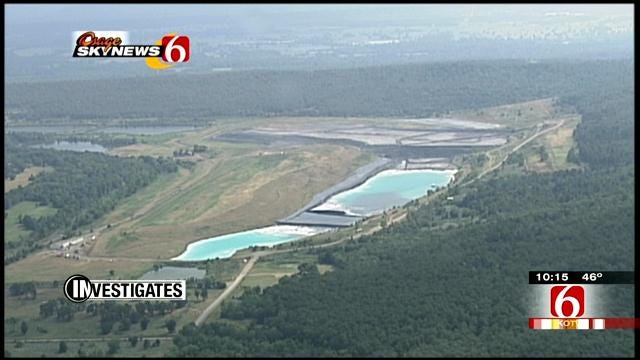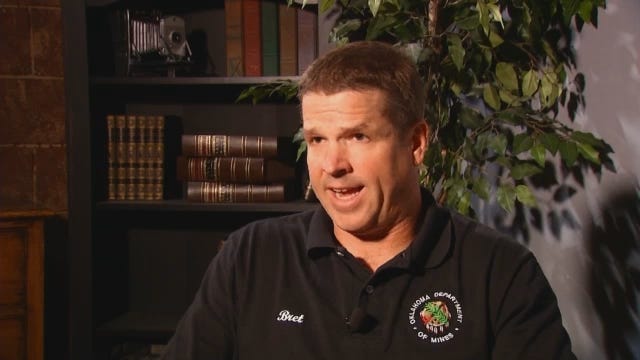Oklahomans Claim Fracking Waste Polluted Their Water
Three years ago 6 Investigates told you about pollution problems in Bokoshe, in LeFlore County. People there claim they are being poisoned by a coal ash disposal site.Monday, November 11th 2013, 6:18 pm
The battle over a toxic Oklahoma dumpsite has taken a remarkable turn. Three years ago, 6 Investigates told you about pollution problems in Bokoshe, in LeFlore County. People there claim they are being poisoned by a coal ash disposal site. The local power plant, AES Shady Point, has dumped enough coal ash there to build a 20-acre mountain less than a mile from town. It's loaded with chemicals like arsenic, mercury, chromium and lead, all of which are known to cause cancer.
But residents have just learned wastewater from the oil and gas process called fracking has added to the contamination, and they say it's reached Oklahoma's underground drinking water.
In a class action lawsuit, Bokoshe residents are now suing nearly 50 companies including the dumpsite owners and oil and gas companies, claiming years of dumping coal ash and fracking wastewater created a critically dangerous threat to their health and property.
Bokoshe resident Dub Tolbert has led the fight to stop coal ash from being dumped there ever since the dumpsite became his next-door neighbor in 1998. Then, he discovered that the tanker trucks that so often lined the rural roads there had been dumping hundreds of millions of gallons of fracking wastewater in Bokoshe's dumpsite.
Fracking wastewater often contains high levels of salt and toxic chemicals. It's a by-product of fracking: pushing huge amounts of water, sand and chemicals underground to release oil and gas. When the fracking wastewater comes back up, it has to be disposed of very carefully.
10/28/2010 Related Story: Oklahoma Fails Small Town In Fly Ash Regulation
We uncovered documents from 2009 tracking truckloads of fracking wastewater directly from oil and gas wells in Arkansas to Bokoshe. Documents show some of the Arkansas frack jobs used thousands of gallons of hydrochloric acid and millions more gallons of undisclosed chemicals. Officials with the Arkansas Oil and Gas Commission say all fracking wastewater has to be disposed of in injection wells in that state. It cannot be dumped there.
Also in 2009, an inspection by the Environmental Protection Agency found toxic contaminants were running off the Bokoshe dumpsite, into the tributary of a creek that runs right through nearby residential property. Attorneys for the Bokoshe residents claim that wastewater has polluted, not just surface water, but underground drinking water, as well.
"It's a very serious problem and it's not going to go away. It's not going to go away because they quit dumping. It's not like a landfill. It's going to continue to pollute this countryside," said Randy Miller, an attorney for the plaintiffs.
Residents can prove toxins have polluted their water and their lawsuit is trying to prove it's also causing the cancer.
Read A May 2010 EPA Inspection Report Of The Site
Dub Tolbert and his neighbors claim that pollution is putting their health at risk. As their lawsuit states, there are "significant concentrations of cancer victims" near the dumpsite. They say 14 of the people who live closest to it were diagnosed with cancer in the last seven years.
We visited the dumpsite office to get their side. A spokesperson said, "I mean it is what it is. It's in court. We're doing everything that we're supposed to be doing," but refused further comment.
It turns out the owners of the dumpsite, a company called Making Money Having Fun, had permits from the state to dump the coal ash and "produced water" at the site.
Produced water is the fluid that comes to the surface of a well before, during and after it produces oil and gas. According to state regulators at the Oklahoma Corporation, it's considered a deleterious substance and includes fracking wastewater.
State regulators with the Oklahoma Department of Mines were in charge of inspecting the site, because it's actually permitted as a mine reclamation project. They required site operators to test the wastewater before it was accepted to make sure it wasn't too polluted, but those tests were based on the honor system and were never certified nor even witnessed by authorities.
"Frankly...it's a 'not in my backyard' kind of thing," said Bret Sholar, former ODM inspector. "I would be concerned if it was in mine, just because of what it is. It's a big fly ash site..."
Sholar was the inspector responsible for enforcing state regulations at the site when the wastewater was dumped there, yet he says it wasn't his job to know what was in the wastewater. He pointed us to the Oklahoma Corporation Commission, which regulates our oil and gas industry.
12/16/2010 Related Story: Oklahoma Senator Inhofe, Congressman Boren Take Up Fly Ash Fight
"They're the ones that authorized the water and where it came from, so they could probably answer that question a whole lot better than I could. Otherwise, I'd be guessing," said Sholar.
Sholar did acknowledge that once the wastewater was on site, it was the responsibility of his agency. That's why, he said, his agency has always required regular water monitoring on the site. The results, he says, have never given him any cause for concern. But, at the same time, he admits the EPA's water testing results were concerning enough to stop fracking wastewater from being dumped there.
"We decided it was not something that we wanted to accept anymore...just as a policy" said Sholar. "Because of some of the concerns that people had, whether they're valid or not, we decided we're just not going to accept water at sites anymore."
The Oklahoma Corporation Commission also pulled its permit, meaning oil and gas companies haven't been able to dump fracking wastewater in Bokoshe since 2009.
Dub Tolbert and his neighbors fear it's too little too late.
"But, we will get something done about it. I think, sooner or later, there'll be enough people that understand and say 'You know, we don't need to make that mess down there in Oklahoma,'" said an emotional Tolbert.
The lawsuit, he says, may be their last hope.
The permit to dump coal ash there is still active. State regulators confirmed the power plant can dump the ash there for another 30 years.
More Like This
November 11th, 2013
April 15th, 2024
April 12th, 2024
March 14th, 2024
Top Headlines
April 23rd, 2024
April 23rd, 2024
April 23rd, 2024
April 23rd, 2024
















